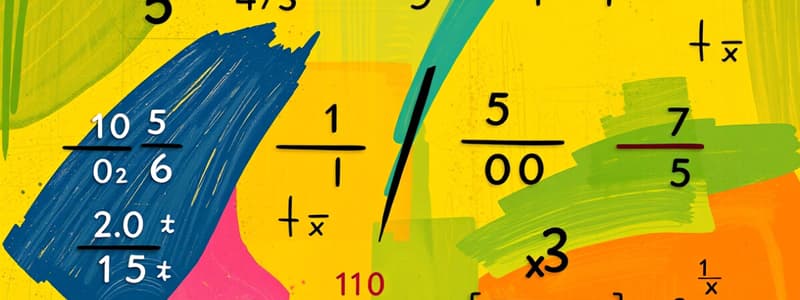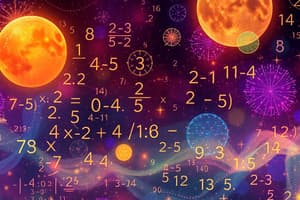Podcast
Questions and Answers
What is the correct definition of median in a data set?
What is the correct definition of median in a data set?
- The middle value in a sorted data set (correct)
- The average of all numbers
- The largest number in the set
- The most frequently occurring number
Which property asserts that the order of addition does not impact the result?
Which property asserts that the order of addition does not impact the result?
- Associative Property
- Commutative Property (correct)
- Identity Property
- Distributive Property
Which of the following is a characteristic of rational numbers?
Which of the following is a characteristic of rational numbers?
- Can only be negative
- Can be expressed as a fraction (correct)
- Includes only integers
- Always whole numbers
In the order of operations stated by PEMDAS, which operation comes last?
In the order of operations stated by PEMDAS, which operation comes last?
Which of the following statements is true about whole numbers?
Which of the following statements is true about whole numbers?
What does the Distributive Property articulate?
What does the Distributive Property articulate?
What is the result of simplifying the fraction 8/12?
What is the result of simplifying the fraction 8/12?
What does the term 'proportion' mean in mathematics?
What does the term 'proportion' mean in mathematics?
How do you convert the fraction 3/5 to a decimal?
How do you convert the fraction 3/5 to a decimal?
Which statement accurately describes perimeter?
Which statement accurately describes perimeter?
What is the mean of the data set: 4, 8, 6, 10?
What is the mean of the data set: 4, 8, 6, 10?
What is the volume of a cube with side length of 3 units?
What is the volume of a cube with side length of 3 units?
When rounding the decimal 3.456 to the hundredths place, what is the result?
When rounding the decimal 3.456 to the hundredths place, what is the result?
If a shirt costs $40 and is on sale for 25% off, what is the sale price?
If a shirt costs $40 and is on sale for 25% off, what is the sale price?
Study Notes
Basic Arithmetic
- Addition: Combining two or more numbers to get a sum.
- Subtraction: Finding the difference between two numbers.
- Multiplication: Repeated addition of a number.
- Division: Splitting a number into equal parts.
Fractions
- Numerator: The top part of a fraction indicating how many parts are taken.
- Denominator: The bottom part indicating how many equal parts the whole is divided into.
- Equivalent Fractions: Different fractions that represent the same value (e.g., 1/2 = 2/4).
- Simplifying Fractions: Reducing fractions to their simplest form.
Decimals
- Place Value: Each digit has a value based on its position (tenths, hundredths, etc.).
- Converting Fractions to Decimals: Divide the numerator by the denominator.
- Rounding Decimals: Adjusting a decimal to a specified place value.
Ratios and Proportions
- Ratio: A comparison of two quantities (e.g., 3:2).
- Proportion: An equation stating that two ratios are equal (e.g., 3/4 = 6/8).
Percentages
- Percentage: A fraction out of 100 (e.g., 50% = 50/100).
- Calculating Percentages: Multiply the whole by the percentage (in decimal form).
Algebra
- Variables: Symbols (usually letters) that represent unknown values (e.g., x, y).
- Expressions: Combinations of numbers and variables (e.g., 3x + 2).
- Equations: Statements that two expressions are equal (e.g., 2x + 3 = 7).
- Solving Equations: Finding the value of variables that make the equation true.
Geometry
- Shapes: Basic shapes include triangles, squares, rectangles, and circles.
- Area: Measurement of the space within a shape (e.g., Area of a rectangle = length × width).
- Perimeter: The distance around a shape (e.g., Perimeter of a rectangle = 2(length + width)).
- Volume: Space occupied by a 3D object (e.g., Volume of a cube = side³).
Statistics
- Mean: Average of a data set (sum of numbers divided by count).
- Median: Middle value in a sorted data set.
- Mode: The most frequently occurring number in a data set.
Measurement
- Units: Common units include inches, feet, meters, liters, and grams.
- Conversions: Changing from one unit to another (e.g., 1 inch = 2.54 cm).
Order of Operations
- PEMDAS: Parentheses, Exponents, Multiplication and Division (left to right), Addition and Subtraction (left to right).
Basic Number Properties
- Commutative Property: Order of addition or multiplication does not change the result (a + b = b + a).
- Associative Property: Grouping of numbers does not affect sum or product ((a + b) + c = a + (b + c)).
- Distributive Property: a(b + c) = ab + ac.
Number Types
- Natural Numbers: Positive integers (1, 2, 3,...).
- Whole Numbers: Natural numbers including zero (0, 1, 2, 3,...).
- Integers: Whole numbers and their negatives (...,-3, -2, -1, 0, 1, 2, 3,...).
- Rational Numbers: Numbers that can be expressed as a fraction (e.g., 1/2, 0.75).
- Irrational Numbers: Numbers that cannot be expressed as a simple fraction (e.g., √2, π).
Basic Arithmetic
- Addition is the process of combining two or more numbers to obtain a total sum.
- Subtraction calculates the difference between two numbers, identifying how much one number is less than the other.
- Multiplication involves repeated addition of a number, making it an efficient way to calculate total amounts.
- Division is used to split a number into equal parts, determining how many times one number fits into another.
Fractions
- The numerator is the upper part of a fraction indicating how many parts are counted from the whole.
- The denominator is the lower part of a fraction that shows how many equal parts the whole is divided into.
- Equivalent fractions are distinct fractions that represent the same quantity, such as 1/2 being equal to 2/4.
- Simplifying fractions involves reducing them to their simplest form, making them easier to work with.
Decimals
- Place value assigns a value to each digit in a decimal based on its position, such as tenths and hundredths.
- To convert fractions to decimals, divide the numerator by the denominator for the decimal equivalent.
- Rounding decimals involves adjusting their value to a specific decimal place for simplicity or clarity.
Ratios and Proportions
- A ratio is a comparison between two quantities, often expressed in the form of a fraction, such as 3:2.
- A proportion states that two ratios are equal, exemplified by equations like 3/4 = 6/8.
Percentages
- A percentage represents a fraction of 100, such as 50% correlating to 50 out of 100.
- To calculate percentages of a whole number, multiply that number by the percentage expressed as a decimal.
Algebra
- Variables are symbols (commonly letters like x and y) that represent unknown quantities in algebraic expressions.
- Expressions combine numbers and variables, such as 3x + 2, to convey a mathematical relationship.
- Equations are statements asserting the equality of two expressions, like 2x + 3 = 7.
- Solving equations involves determining the values of the variables that make the equation valid.
Geometry
- Basic geometric shapes include triangles, squares, rectangles, and circles, each with distinct properties.
- Area measures the space contained within a shape, calculated differently depending on the shape’s dimensions (e.g., rectangle area = length × width).
- Perimeter calculates the total distance around a shape, for example, the perimeter of a rectangle is found using the formula 2(length + width).
- Volume quantifies the space occupied by three-dimensional objects, with the volume of a cube calculated as side³.
Statistics
- The mean is the average of a data set, found by dividing the sum of the numbers by the quantity of numbers.
- The median is the middle value in an ordered data set, providing a measure of central tendency.
- The mode is the value that appears most frequently in a data set, useful for understanding common occurrences.
Measurement
- Common units for measurement include inches, feet, meters, liters, and grams, which are essential for quantifying different types of measurements.
- Conversions allow the transformation from one unit to another, such as knowing that 1 inch is equivalent to 2.54 centimeters.
Order of Operations
- PEMDAS is an essential rule for solving mathematical expressions, indicating the order to solve problems: Parentheses, Exponents, Multiplication and Division (from left to right), Addition and Subtraction (from left to right).
Basic Number Properties
- The Commutative Property states that the order of addition or multiplication does not alter the outcome (e.g., a + b = b + a).
- The Associative Property indicates that the grouping of numbers in addition or multiplication does not affect the total (e.g., (a + b) + c = a + (b + c)).
- The Distributive Property allows for the expansion of expressions, demonstrated by a(b + c) = ab + ac.
Number Types
- Natural numbers are counted as positive integers starting from 1 (e.g., 1, 2, 3,...).
- Whole numbers encompass natural numbers alongside zero (0, 1, 2, 3,...).
- Integers include whole numbers and their negative counterparts (...,-3, -2, -1, 0, 1, 2, 3,...).
- Rational numbers can be expressed as fractions, such as 1/2 or 0.75.
- Irrational numbers cannot be represented as simple fractions, examples include √2 and π.
Studying That Suits You
Use AI to generate personalized quizzes and flashcards to suit your learning preferences.
Description
Test your knowledge on basic arithmetic operations, fractions, decimals, and ratios. This quiz covers essential math concepts including addition, subtraction, multiplication, and division, as well as understanding fractions and their properties. Perfect for beginners looking to strengthen their foundational math skills.




